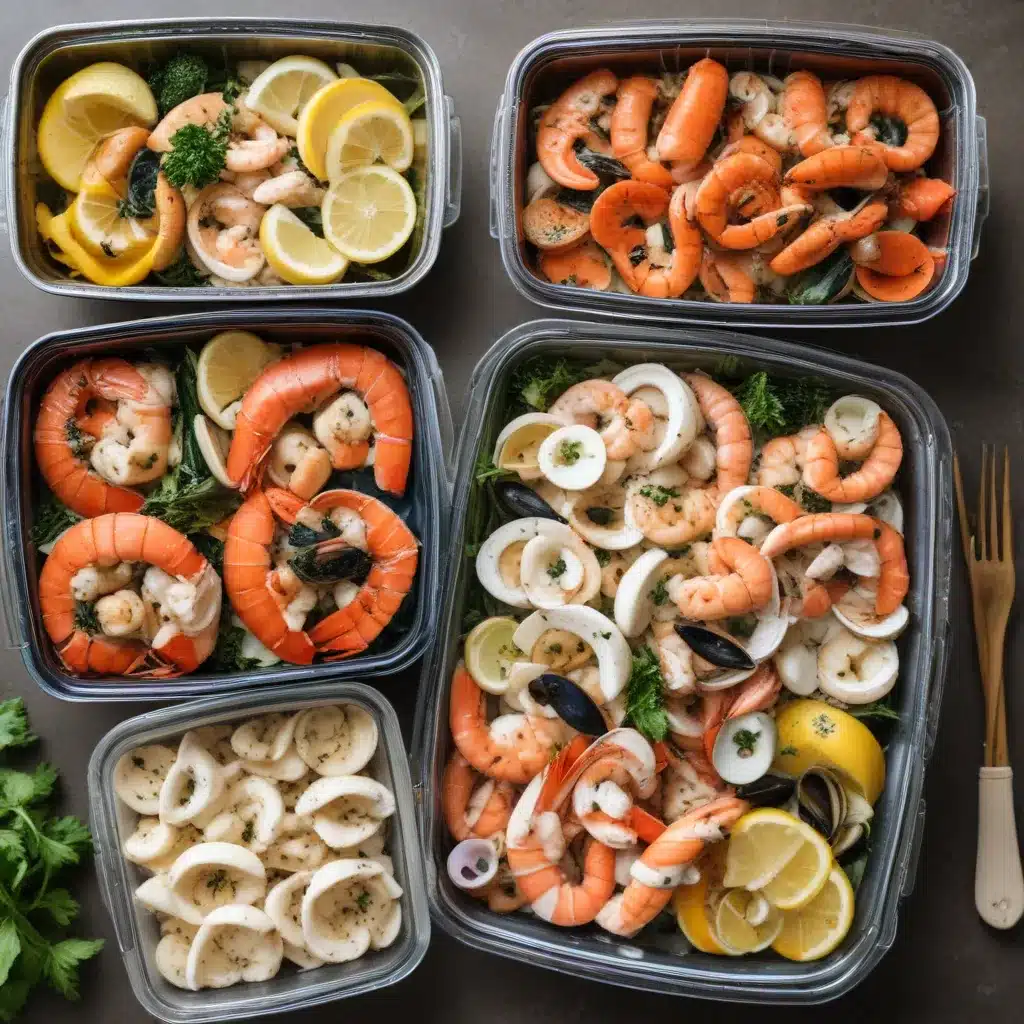
As a seafood dining expert for Fish Tales Cafe, I’m excited to share my top tips and strategies for simplifying your meals through smart seafood storage and seamless meal planning. Whether you’re a seasoned home chef or just starting to explore the world of cod and other fresh catches, this comprehensive guide will empower you to enjoy delectable seafood dishes with minimal hassle.
Seafood Storage Strategies
Properly storing your seafood is the foundation for creating memorable meals. Let’s dive into the essentials of refrigeration, freezing, and preserving freshness to ensure your ingredients stay at their peak.
Refrigeration Essentials
When it comes to storing fresh cod or other finfish, the refrigerator is your best friend. Aim to keep them at a temperature between 32-40°F (0-4°C) and consume within 1-2 days of purchase. For shellfish like shrimp or scallops, a slightly colder fridge at 28-32°F (-2 to 0°C) will prolong their shelf life by 3-5 days. Always keep seafood on the bottom shelf, below any raw meat, to prevent cross-contamination.
Freezing Seafood Safely
Freezing is a game-changer for seafood meal prep. Cod, salmon, tuna, and other firm-fleshed fish can be frozen for 3-6 months, while delicate shellfish like oysters or mussels last 2-3 months. Wrap fillets or steaks tightly in plastic wrap or freezer-safe bags, removing as much air as possible. Freeze on a flat surface, then transfer to containers for easy stacking. When ready to use, thaw in the refrigerator for 12-24 hours.
Preserving Freshness
Beyond temperature control, a few other tactics can help maintain the quality of your seafood. Brining fish in a saltwater solution before freezing can improve texture and flavor. Vacuum sealing removes air pockets to inhibit freezer burn. For short-term storage, keep cod or other finfish submerged in acidic marinades like lemon juice or vinegar, which slows enzyme activity.
Meal Planning with Seafood
With your storage foundations in place, let’s explore strategies for seamlessly incorporating seafood into your weekly meal plans. From versatile dishes to streamlined shopping, I’ll share my top tips.
Versatile Seafood Dishes
The beauty of seafood is its remarkable versatility. Cod, for example, can be baked, pan-seared, or en papillote (in parchment paper) for easy weeknight dinners. Shellfish like shrimp or scallops are perfect for quick stir-fries or Ceviche-style “cooked” salads. And don’t forget about fish tacos, soups, or casseroles – the options are endless!
Meal Prep Techniques
Meal prepping seafood couldn’t be simpler. Sous vide cooking allows you to precisely cook fillets or portions ahead of time, then quickly sear or broil when ready to serve. Seafood cakes or fritters made with canned tuna, salmon, or even cod can be prepped in advance and frozen. And pre-marinated or seasoned proteins make for effortless assembly come mealtime.
Streamlined Shopping
To minimize trips to the store, stock up on versatile frozen seafood like cod, shrimp, or salmon. Pair these with canned or jarred items like tuna, sardines, or even crab meat for easy protein-packed salads, sandwiches, or pasta dishes. And don’t forget to keep an eye out for sales or discounts on fresh catches at your local fish market or grocery store.
Seafood Handling Hacks
Elevating your seafood game involves more than just storage and planning. Mastering a few key techniques for thawing, cleaning, and prepping can make a world of difference.
Thawing Procedures
For the best results, thaw frozen seafood in the refrigerator over 12-24 hours. This gradual process helps preserve texture and flavor. In a pinch, you can also use the “cool water” method, submerging the sealed package in cold tap water and changing the water every 30 minutes.
Cleaning and Prepping
Properly cleaning and preparing seafood is essential. For cod or other finfish, gently rinse under cool water, pat dry, and remove any pin bones with tweezers. Shellfish like shrimp or scallops may need deveining or shucking, so have the right tools on hand. These small steps make a big difference in the final dish.
Minimizing Waste
To reduce food waste, keep a running inventory of your seafood stash, either in a digital document or on a whiteboard in your kitchen. This helps you quickly assess what needs to be used up first. Additionally, utilize every part of the fish or shellfish – save trimmings for flavorful seafood stock or chowders.
Nutritional Benefits of Seafood
Beyond the delicious flavors and satisfying textures, seafood offers an array of remarkable health benefits that make it a must-have in any well-rounded diet.
Omega-3 Fatty Acids
Fatty fish like cod, salmon, and mackerel are rich in omega-3 fatty acids, which are essential for heart, brain, and eye health. Incorporating these nutrient-dense proteins into your weekly meal plans can have far-reaching positive impacts.
Protein-Rich Meals
Seafood is an excellent source of high-quality, lean protein, making it a perfect building block for balanced, satiating meals. Whether you prefer cod fillets, grilled shrimp, or crab cakes, you’ll be fueling your body with the essential amino acids it needs.
Micronutrient Powerhouse
In addition to protein and omega-3s, seafood is teeming with a variety of vital micronutrients. Cod, for instance, is an outstanding source of vitamins B12 and D, as well as minerals like selenium and iodine. Shellfish, too, offer a treasure trove of zinc, copper, and iron.
By mastering the art of seafood storage, meal planning, and preparation, you’ll unlock a world of culinary possibilities and nutritional benefits. Whether you’re craving a comforting cod chowder, a vibrant ceviche, or a quick and easy seafood stir-fry, the strategies outlined in this guide will empower you to savor the bounty of the sea with minimal stress. Happy cooking, and bon appétit from Fish Tales Cafe!

